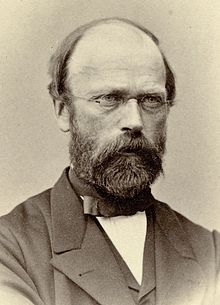Jens Andreas Friis (2 May 1821 – 16 February 1896) was a Norwegian philologist, lexicographer and author. He was a university professor and a prominent linguist in the languages spoken by the Sami people. He is widely recognized as the founder of the studies of the Sami languages. Today he is also commonly associated with his novel Lajla: A New Tale of Finmark, which became the basis for Laila, a 1929 silent film.[1][2][3]

Background edit
Friis was born in Sogndal in Sogn og Fjordane, Norway. He was the son of church vicar Soren Hjelm Friis (1781–1856) and Charlotte Lovise Cammermeyer (1789–1869). He was the brother of priest and politician Nicolai Friis. Friis completed his final exams from Møllers Institute in Christiania in 1840 and earned his cand.theol. in 1844. From 1847 to 1849, he was a research fellow in Sami and Finnish. By the autumn of 1849, he went on a grant to Kajaani, Finland to continue his studies under Lönnrot Elias, the founder of Finnish folklore studies. Friis stayed for a time in Finnmark and in return he assumed teaching ministry for priests.[4]
Career edit
Friis was appointed reader in Sami languages at the University of Kristiania (now University of Oslo) in 1863. Three years later he was awarded a chair in the Lapp and Kven languages, with a special duty in translation. He published on the Sami language and mythology as well as travel literature about Northern Norway. Friis established the northern Sami orthography, which although modified through three spelling reforms is in common usage. Until the Konrad Nielsen's dictionary Lappisk ordbok was published in three volumes between 1932 and 1938, Friis' Sami dictionary was the most important of its kind. Friis also translated With Nansen over Greenland in 1888: My journey from Lapland to Greenland by Samuel Balto from the original Sami into the Norwegian language.[5]
Friis' ethnographic maps edit
Friis published three series of thematic maps covering Norway north of the Ofotfjord. The first edition was published in 1861, and the second in 1888/1890. Each household was coded with a three-way symbol denoting 1) ethnic group 2) household member's fluency in Norwegian, Sami, and Kven, and 3) whether the family lived in a goahti. These maps, in addition to the censuses of 1865, 1875, 1891, and 1900, provide a valuable resource of knowledge of the ethnicity and language in the circumpolar region decades before the enforcement of Norwegian as the single official language in schools.
Selected works edit
- Lappisk Grammatik, 1856
- Lappiske Sprogprøver. En Samling af Lappiske Eventyr, Ordsprog og Gaader med Ordbog, 1856
- Lappisk Mythologi, Eventyr og Folkesagn, 1871
- En Sommer i Finmarken, Russisk Lapland og Nordkarelen. Skildringer af Land og Folk, 1871
- Hans Majestæt Kong Oscar II's Reise i Nordland og Finmarken Aar 1873, 1874
- Tilfjelds i Ferierne eller Jæger- og Fiskerliv i Høifjeldene, 1876
- Fra Finmarken. Skildringer, 1881
- Klosteret i Petschenga. Skildringer fra Russisk Lapland, 1884
- Ordbog over det Lappiske Sprog, 1887
- Skildringer fra Finmarken, 1891
References edit
- ^ Lajla: A New Tale of Finmark (G.P. Putnam. 1888) Retrieved June 20, 2016
- ^ Svenn-Egil Knutsen Duolljá Jens Andreas Friis (Store norske leksikon)
- ^ James Steffen. "Laila (1929)". Turner Classic Movies, Inc. Retrieved June 20, 2016.
- ^ "Søren Hjelm Friis". nrk.no. Retrieved June 20, 2016.
- ^ Hans Lindkjølen. "J A Friis, Forfatter, Språkforsker". Norsk biografisk leksikon. Retrieved June 20, 2016.
Other sources edit
- Lindkjølen, Hans (1983) J. A. Friis og samene (Hønefoss: Tyri forlag) ISBN 82-7122-000-4
- Hansen, Lars Ivar (1998) Friis' etnografiske kart i Ottar Tidsskrift fra (Tromsø Museum)